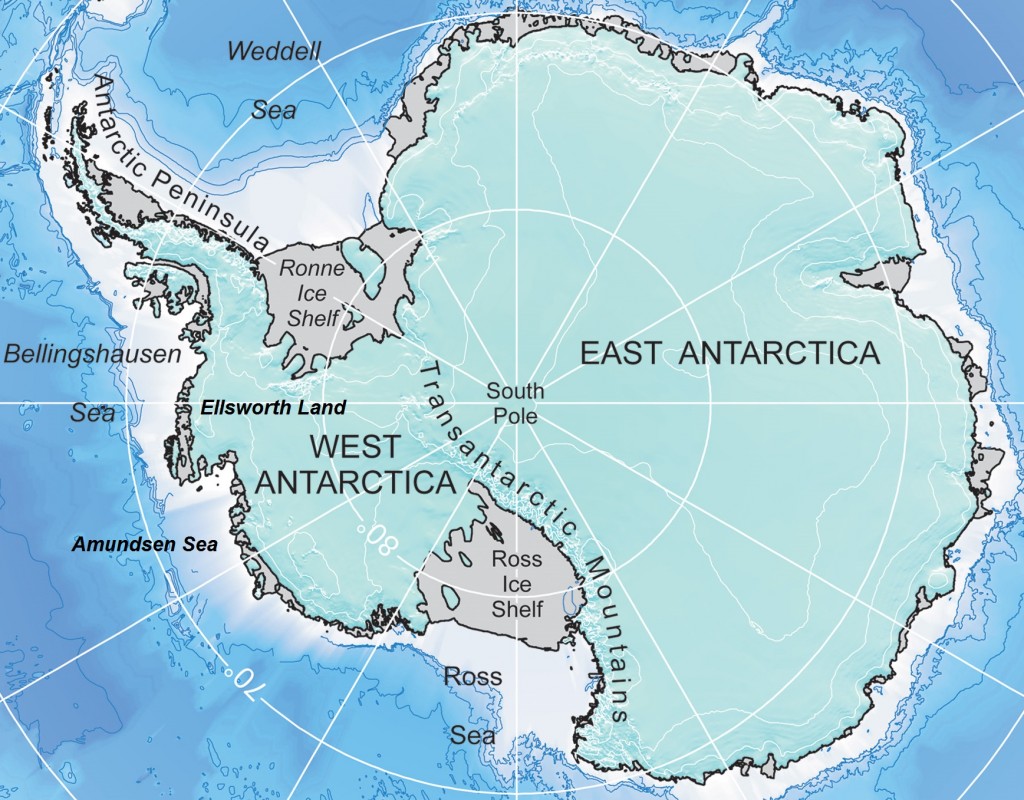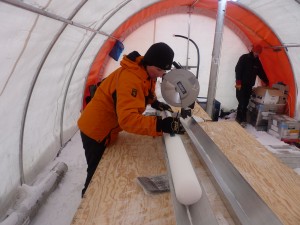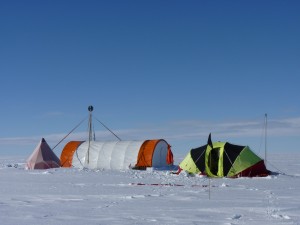4 November 2015
WASHINGTON, DC — Annual snow accumulation on West Antarctica’s coastal ice sheet increased dramatically during the 20th century, according to a new study published in the American Geophysical Union journal Geophysical Research Letters.
The research gives scientists new insight into Antarctica’s blanket of ice. Understanding how the ice sheet grows and shrinks over time enhances scientists’ understanding of the processes that impact global sea levels, according to the study’s authors.
The new study used ice cores to estimate annual snow accumulation from 1712 to 2010 along West Antarctica’s coast. Until 1899, annual snow accumulation remained steady, averaging 33 and 40 centimeters (13 and 16 inches) of water, or melted snow, each year at two locations.
Annual snow accumulation increased in the early 20th century, rising 30 percent between 1900 and 2010, according to the new study. The study’s authors found that in the last 30 years of the study, the ice sheet gained nearly 5 meters (16 feet) more water than it did during the first 30 years of the studied time period.
“Since the record is 300 years long, we can see that the amount of snow that has been accumulating in this region since the 1990s is the highest we have seen in the last 300 years. The 20th century increases look unusual,” said Elizabeth Thomas, a paleoclimatologist with the British Antarctic Survey in Cambridge, United Kingdom, and lead author of the new study.
Thomas attributes the higher annual snow accumulation over the last 30 years in part to an intensification of a regional low pressure system and more storms in the region. The study’s authors said these storms could increase with climate change, possibly leading to further increases in snow accumulation.
Snow accumulation builds up the ice sheet, but the extra flakes have not acted as a life raft for West Antarctica’s ice sheet, which previous research has found is rapidly thinning as the climate warms, Thomas said.
The size of the ice sheet depends on how much new snow accumulates and how much of the existing ice melts, she said. Knowledge about how much new snow is laid down in West Antarctica each year could help scientists more accurately predict how the region’s coastal ice sheet could be affected by climate change and its contribution to sea level rise, Thomas said.
“In this region, the same [storms] that have driven increased snowfall inland have brought warmer ocean currents into contact with West Antarctic’s ice shelves, resulting in rapid thinning,” said Thomas. “Thus the increased snowfall we report here has not led to thickening of the ice sheet, but is in fact another symptom of the changes that are driving contemporary ice sheet loss.”

Many of the glaciers in Ellsworth Land, West Antarctica, are thinning quickly, adding to sea level rise.
Credit: British Antarctic Survey
Ice on West Antarctica’s coast
Earth has two ice sheets – one in the Arctic, covering Greenland, and one sitting on Antarctica. Ice sheets start their lives as snowflakes. When snowfall builds up year after year, the weight of the snow compresses the bottom layers into ice, creating an ice sheet.
Scientists can calculate snow accumulation from satellite data, but satellite records have only existed since 1979. That’s too short a time period to determine whether any changes in snowfall are the result of natural variation or shifts in the climate, Thomas said.
“We need to understand whether we are losing ice, at what rate, and what is causing it,” she said.
For the new study, researchers collected two ice cores from Ellsworth Land, the strip of land that connects the Antarctic Peninsula to the rest of the continent. The ice cores contain layer upon layer of ice – the remnants of yearly snowfall. By measuring the thickness of the ice laid down each year, the researchers estimated annual snow accumulation for the past 300 years.
The recent heavy snow accrual appears to be part of a gradual, long-term rise in annual snow accumulation that started in the early 1900s and accelerated in the 1980s, the study found. The study’s authors found that starting in the early 20th century an additional 1.5 centimeters (0.6 inches) of water, or melted snow, was added to the ice sheet each decade. From 2001 to 2010, the amount of water added to the ice sheet each year was 15 centimeters (6 inches) greater than it was before 1900, according to the study’s authors.
A stormy sea
The study’s authors attribute the rise in snow accumulation in part to increased regional storm activity. The Amundsen Sea, which bounds Ellsworth Land to the west, is prone to storms and low pressure systems that often sit over the region, Thomas said.
Meteorological data, which only date back 35 years, show the low pressure system has strengthened during that time, leading to more storms swirling around the Amundsen Sea and potentially greater snow accumulation, according to the paper. The uptick in snow accumulation since the 1920s may suggest an even longer trend of increasing storms, Thomas said.
Scientists have not pinpointed the reason for the strengthening of the low pressure system in the Amundsen Sea, but the number and intensity of storms in the region could continue to increase throughout the 21st century as a consequence of greenhouse gas warming, Thomas said. In a warmer climate, air travelling south from the mid-latitudes and tropics can hold more water, leading to more snowfall, Thomas said.
The paper draws a convincing connection between the intensification of the Amundsen Sea low-pressure system and increasing snow accumulation, said David Bromwich, a polar weather and climate scientist with the Byrd Polar and Climate Research Center at Ohio State University in Columbus, who was not an author on the new paper. The low-pressure system is likely one of several factors contributing to the increase in snowfall, he said.
Antarctic climate results from a complex mix of oceanic and atmospheric circulation patterns, so there could also be other components affecting the amount of snow accumulation in the region, Bromwich said. As the paper suggests, one could be the evaporation of surface waters that have become exposed because of sea ice loss in the region, he added.
View the press release on the British Antarctic Survey website.
###
The American Geophysical Union is dedicated to advancing the Earth and space sciences for the benefit of humanity through its scholarly publications, conferences, and outreach programs. AGU is a not-for-profit, professional, scientific organization representing more than 60,000 members in 139 countries. Join the conversation on Facebook, Twitter, YouTube, and our other social media channels.
Notes for Journalists
Journalists and public information officers (PIOs) of educational and scientific institutions who have registered with AGU can download a PDF copy of the article by clicking on this link: http://onlinelibrary.wiley.com/doi/10.1002/2015GL065750/abstract?campaign=wlytk-41855.5282060185
Or, you may order a copy of the final paper by emailing your request to Leigh Cooper at [email protected]. Please provide your name, the name of your publication, and your phone number.
Neither the paper nor this press release is under embargo.
“Twentieth century increase in snowfall in coastal West Antarctica”
Authors:
E.R. Thomas, J.S. Hosking, R.R. Tuckwell, R.A. Warren, and E.C. Ludlow: British Antarctic Survey, Madingley Road, Cambridge CB3 0ET, UKE.
Contact Information for the Authors:
Liz Thomas: [email protected], 07967 127295 (Wednesday, November 4), 01223 221658 (Thursday, November 5)
Leigh Cooper
+1 (202) 777-7324
[email protected]
British Antarctic Survey contact:
Athena Dinar
+44 1223 221441
+44 7909 008516
[email protected]

